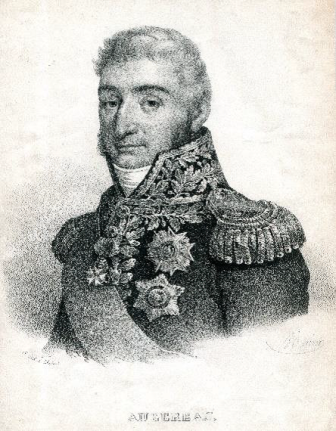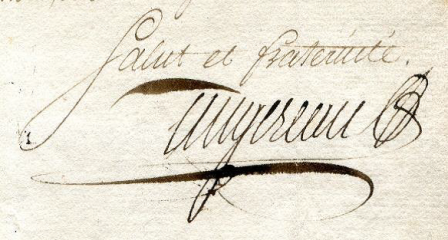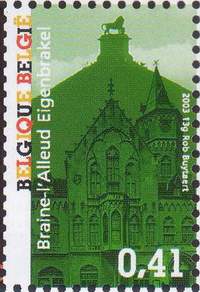Manifestations (préventes, bourses, etc...)
Exposition internationale et bureau temporaire Braphil '15
JØRGENSEN Carl E. Frederica Académie Européenne de Philatélie
France at war 1792-1814
As historian I have since my youth been using stamps and covers to illustrate the run of history. It turned into a large collection. As from 1965 I have been exhibiting parts of it: “War covers 1795-1870”, “The Nordic Countries during WWII”, “Danish UN Peace Keepers’ Mail” etc.
An experienced philatelist advised me to concentrate on a more narrow topic. This advice I followed and up through the 1970s my collection of French military mail from the Napoleonic period was constantly enhanced. It was not always easy to acquire new material, but I established contacts with a couple of large stamp houses in the UK and France. Also a major dealer of old books could on occasion help out from their special section for autographs. This source supplied me with a couple of letters signed by French generals. One of them was without the outer letter-sheet and thus without postal markings, but it was accompanied by a cobber etching showing Marshal Augereau, who had signed the letter. I was pleased to include both items in my exhibit.
I exhibited at various international stamp exhibitions across Europe. I was rewarded with a number of medals which still make me proud. In contrast it was mostly a disappointing experience to exhibit in my home country, Denmark: It was recognized that the collection did tell a good and interesting story, but the jury put more emphasis on the lack of displayed philatelic knowledge. There was no information on postal rates, the markings were organised in apparent disorder and were not grouped by type and there were no information on periods of use. The etching of Augereau was not philately nor postal history and I think it gave a points’ deduction rather than adding to the total. I obtained a couple of diplomas – and then I stopped showing my French Military mail for 30 years.
In the 1990s I got the idea to structure the collection according to the philosophy of the new open class philately. I bought pictures of French soldiers during a holiday in France and invested a small fortune in colour photos of the “reverse” of the letter sheets – i.e. the side with the address and the postal markings – when I wanted to show the beautiful letter-head; and of the contents when I prioritised showing the outside cover and a clear strike of a hand-stamp. The actual mounting according to the new concept took place in year 2000. I mounted on burgundy coloured paper, and I still find it gives a good effect. I have shown the collection in a couple of societies accompanied by a small lecture but not in competition at any exhibition.
In the open class it is completely legitimate to show the content of the letters and the bulletin sent by a soldier or authority. But granted, the historian finds more of interest than the philatelist. What I found the most fascinating was an elaborate list over the belongings of the late general la Cour. The list was sent to his widow and informs her about the revenue from the sales of the clothes of the general as well as his horse and about the expenses for his five servants as well as a cash amount of 60 ducats.
Another letter sent from “2e DIV. / ARMÉE D’ITALIE” while at Ollioules (near Toulon) to the Mayor of Montfort. It reads:
« Il nous est parti, hier, le nommé Thomas Trouva de Montfort; cet homme c’est enfui avec trois mules á bâts, qui sont pour l’usage de l’artillerie; Nous vous Prions, citoyens, de nous faire revenir cet homme avec son bêtes et dans le cas, qu’il ne soit pas rendu dans son commune de nous en faire part pour que nous puissions envoyer des gendarmes nationaux á ses trouver.
Salut et fraternité,
Verdeit, inspecteur principal de ‘attelage d’artillerie. »

Etching and signature of Marchal Augereau. Pierre Francois Charres Augereau (1757-1816) worked his way up from private to general, marshal and Duke of Castiglione. He was reckless, greedy and politically ambitious. Militarily he acclaimed himself mostly during the campaigns 1805-07.

 Letter
sent to the Mayor of Montfort. It reads in translation: “He
disappeared on us yesterday, he who is called Thomas Trouva from
Montfort. This man has fled with three pack-mules belonging to the
artillery. We ask you, citizen, to send back this man and the
animals. And in case he has not returned to his commune please let
us know in order for us to send out the national gendarmes to look
for him.
Letter
sent to the Mayor of Montfort. It reads in translation: “He
disappeared on us yesterday, he who is called Thomas Trouva from
Montfort. This man has fled with three pack-mules belonging to the
artillery. We ask you, citizen, to send back this man and the
animals. And in case he has not returned to his commune please let
us know in order for us to send out the national gendarmes to look
for him.

